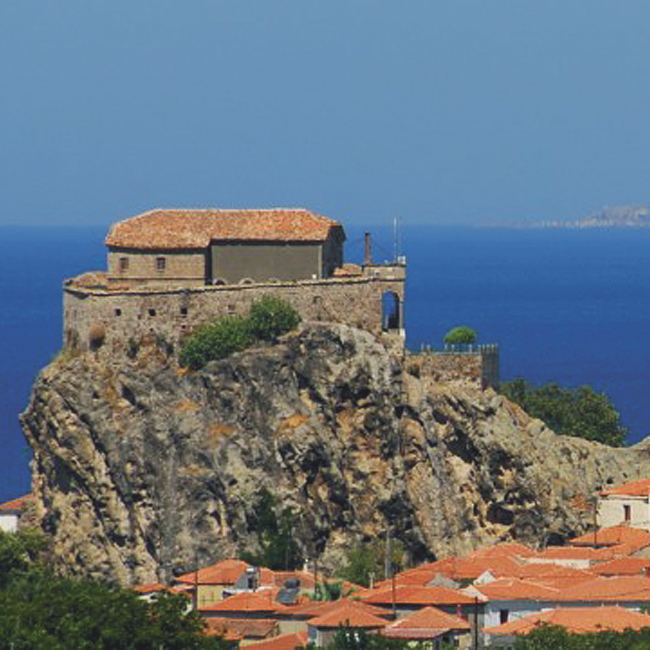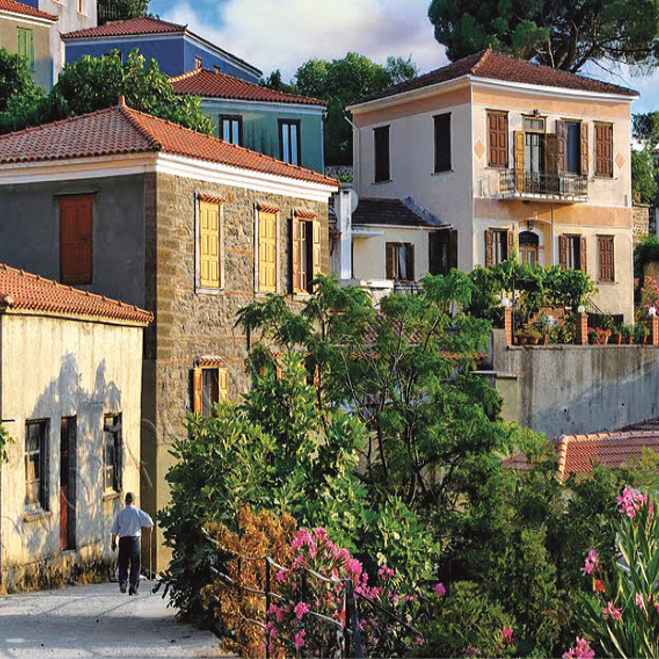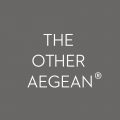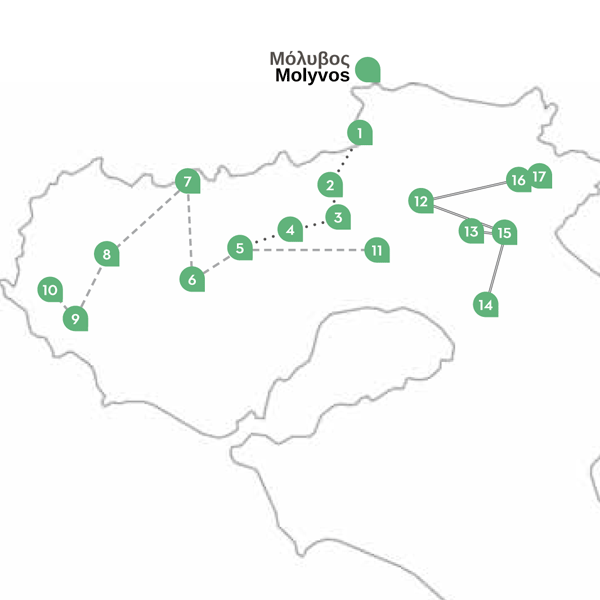More Birds
|
A journey to the northwestern peninsula must include the Petrified Forest (10), an area of 16,600 hectares of great ecological value listed among the European Union’s Natura 2000 natural protection areas and in Unesco’s Global Geoparks Network. This petrified forest ecosystem is a window on the geohistoric development of the Aegean showcasing hundreds of indigenous trees made immortal 20 million years ago by volcanic material that covered them in situ. There are perfectly preserved root systems and standing trunks that exceed 3 metres is diameter and are more than 7 metres tall while many lying trunks exceed 20 metres in length. The namesake Museum is also a “must visit”.Ypsilou Monastery (8) near Antissa is a typical example of ecclesiastical architecture of the 16th century that holds a small but distinguished collection of religious relics and documents. Journeying to the central and northeastern part of the wider region of Molyvos you will want to visit the twin monasteries of the early 16th century: The Nunnery of the Virgin Mirsiniotissa and the Limonos Monastery (11). Built in 1523 and 1527 AD these were significant places of worship and education during the years of the Ottoman occupation of Greece. The library at Limonos Monastery is particularly noteworthy as it’s collections of manuscripts is second only to those held at Mount Athos. At the renowned Monastery of Taxiarches (16) in Madamados you’ll find the miracle working relief icon of Archangel Michael, said to have been shaped with the blood that wet the monastery’s soil when monks were brutally slaughtered by Saracens. The monastery is the site of a national pilgrimage and festival that takes place on Myrrh-bearers’ Sunday. And the Ecclesesiastical-Byzantine Museum in Mytilene exhibits many sacred and valuable icons and other holy relics spanning more than 700 years of Christian history.You must visit the 6th century Temple of Apollo of Napeos in Klopedi (13) is one of the greatest examples of archaic architecture and, continuing on toward the Kalloni salt pans, the aeolian Sanctuary Temple of Meson (14), the religious center of all Lesvos in antiquity, dedicated to Hera, Zeus and Dionysus. In addition to worship, the temple hosted important court hearings and women’s pageants celebrating their physical and spiritual beauty.The Museum of Industrial Olive Oil Production (15) narrates the olive oil tradition of the island. Housed in the large 19th century community olive press building is the “machine of the people” as it was called then. In Madamados, you’ll find the Pottery Museum (17) and a large collection of handicrafts shops that hand-make pottery and are still flourishing. Many events are organized throughout the year and particularly during the Summer months that showcase the island’s traditions, culture, history, cuisine and art including folk, classical, and modern music concerts; drama and theater productions; folk, religious, pagan and other festivals; art exhibitions and literary presentations; and more. |
  |

 In Petra, the church of Panagia Glykofilousa (1) on the imposing rock that overlooks the area and the elegant mansion of “Vareltzidena” mark the social and religious development of the site in the past. Crossing the stone-built, terracotta-tiled villages to the west of the island – Skoutaro (2), Filia (3), Skalochori, Anemotia (4) – with their 17th century churches and impressive mansions, you’ll reach the heritage site of Vatousa (5) an architectural jewel. Visit Aghia Paraskevi, one of the most beautiful small villages on the island and marvel at the 14th century arched, stone bridge of “Kremasti” (12). And don’t miss the technical marvel of the great Roman Aquaduct at Moria built between the 1st and 3rd century AD to supply water to Mytilene from the springs near Agiassos located 26 kilometres away.Those interested in art can’t miss the George Iakovidis Digital Art Museum (6) in Chydira, exhibiting through digital means the rich collection of paintings by this great Greek painter and representative of the German “academic naturalism” school, the so-called “Munich School”; the Theophilos Museum in Varia, housing impressive works by the great local folk painter Theophilos Chatzimichail; and the Teriade Library and Museum of Modern Art (next to the Theofilos Museum), housing publications by the renowned art critic with lithographs, engravings, woodblock prints and watercolours by the likes of Miró, Chagall, Picasso, Matisse, Le Corbusier, Léger, Roualt, Giacometti and Villon, and paintings by the folk painter Theophilos.From ancient Antissa, birthplace of the musician and poet Terpander, and its seaside castle (7) you’ll reach Eressos (9), home of the poet Sappho and of the student of Aristotle, philosopher and father of modern biology, Theophrastus. The town’s small archaeological museum is worth a visit. The acropolis of Eressos, the early Christian Basilica of Aghios Andreas dating back to the 5th century AD, the monasteries of Perivoli and Pithariou and the Sigri Castle built by the Ottoman Turks in 1757 are some of the most important monuments of this area.
In Petra, the church of Panagia Glykofilousa (1) on the imposing rock that overlooks the area and the elegant mansion of “Vareltzidena” mark the social and religious development of the site in the past. Crossing the stone-built, terracotta-tiled villages to the west of the island – Skoutaro (2), Filia (3), Skalochori, Anemotia (4) – with their 17th century churches and impressive mansions, you’ll reach the heritage site of Vatousa (5) an architectural jewel. Visit Aghia Paraskevi, one of the most beautiful small villages on the island and marvel at the 14th century arched, stone bridge of “Kremasti” (12). And don’t miss the technical marvel of the great Roman Aquaduct at Moria built between the 1st and 3rd century AD to supply water to Mytilene from the springs near Agiassos located 26 kilometres away.Those interested in art can’t miss the George Iakovidis Digital Art Museum (6) in Chydira, exhibiting through digital means the rich collection of paintings by this great Greek painter and representative of the German “academic naturalism” school, the so-called “Munich School”; the Theophilos Museum in Varia, housing impressive works by the great local folk painter Theophilos Chatzimichail; and the Teriade Library and Museum of Modern Art (next to the Theofilos Museum), housing publications by the renowned art critic with lithographs, engravings, woodblock prints and watercolours by the likes of Miró, Chagall, Picasso, Matisse, Le Corbusier, Léger, Roualt, Giacometti and Villon, and paintings by the folk painter Theophilos.From ancient Antissa, birthplace of the musician and poet Terpander, and its seaside castle (7) you’ll reach Eressos (9), home of the poet Sappho and of the student of Aristotle, philosopher and father of modern biology, Theophrastus. The town’s small archaeological museum is worth a visit. The acropolis of Eressos, the early Christian Basilica of Aghios Andreas dating back to the 5th century AD, the monasteries of Perivoli and Pithariou and the Sigri Castle built by the Ottoman Turks in 1757 are some of the most important monuments of this area.